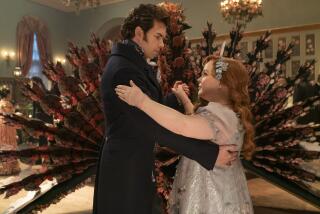Passing Over the Dot-Coms to Run With the Ball
- Share via
The year was 1997. USC’s graduate school of business sizzled with dot-com tales of newly minted millionaires, billionaires and idea men aiming for the millennium equal of a Vegas jackpot: a profit center in cyberspace. The school’s elite entrepreneurial program was packed with student dynamos who had seen the high-tech future and were boldly leaping in.
And then there was Jason Wall, a guy so low-key, earnest and likable that even arrogant classmates didn’t laugh in his face when they heard his big idea: to make and market . . . antenna balls. Wall says they waited until he left the room and laughed behind his back.
Professors rolled their eyes, he says, although none tried to change his path. Not every student is a Gates or a Bezos, they must have told themselves. But what could the future hold for a man who was using student loan money to make little Styrofoam spheres that sit atop the antennas of cars? Even the name that Wall chose was underwhelming, though it was not tacky. Wally Balls was way better than Wally’s Balls.
And so it was that the then-26-year-old son of a Van Nuys dentist, a self-described “totally average guy,” quietly set about to adorn the country’s cars with what USC professor Tom O’Malia even now calls “little knickknacks.”
*
Wall didn’t see things that way. He’d detected an unfulfilled need in the marketplace, a yearning by millions to upgrade their auto decor. They wanted some peppy little kicker to wave in the breeze, salute the great outdoors, identify themselves as . . . well, whatever.
He remembers exactly how his entrepreneurial instincts were aroused: “Inspiration struck when I heard a Jack in the Box commercial in 1997. It said that 3 million of their antenna balls had been sold that year. I knew there had to be a reason people put these things on their cars.”
Wall scoured highways and byways nationwide, trying to solidify his germ of an idea. “I looked everywhere, and there were no antenna balls around except Jack and 76.” He did research: Union 76 had started the trend 30 years ago, offering the balls to purchasers of their gas. The fad faded until Jack in the Box revived it in 1994 with the birth of the lovable bland white Styrofoam smile of Jack, the chain’s fictional chief executive.
“If they’re putting Jack on their cars,” he conjectured, “wouldn’t they pay to express themselves via many different designs? Is there a huge market that absolutely no one has tackled yet?”
O’Malia, director of USC’s Lloyd Greif Center for Entrepreneurial Studies, says it is just such small leaps of imagination that cause fortunes to be made.
“Think Kinko’s,” the professor says. “A huge success like that doesn’t spring, full-fledged, from thin air. It starts with one copier placed in the entranceway of one college dorm in Santa Barbara. A copier placed there by a guy with kinky hair, whose last name starts with the letter O.” In fact, O’Malia says, Wall reminds him very much of Paul Orfalea, the 1970s USC business school graduate who put consumer copying on the map with his Kinko’s chain, and went on to endow the USC chair that O’Malia now holds. “Wall and Orfalea were both enigmas, both cut of the same cloth,” O’Malia says. “Both started small, with an idea on which they could expand.”
*
Wall tracked down the manufacturers of the 76 balls, who produced a test run of four of his own designs--an 8-ball, the peace sign, the happy face and an alien. He placed a bunch of those in a Westwood bread shop owned by the father of a friend, and in four mini-market/gas stations in the San Fernando Valley.
“By the time I had set up the fifth display and went back to the first one, they had already sold four balls in two hours. I knew then I had a business. It took less than a week to sell out 48 pieces in each of five stores.”
His first real account was the am/pm mini market chain, which put 50,000 balls in 1,000 of its stores and sold out in a month.
Wall soon realized “there was a bigger market out there than even I had imagined.” People wanted balls to say “Merry Christmas,” to salute their favorite teams, to announce sexual or cinematic preferences. The number of designs soon grew to 50 and he continues to add new ones, such as the upcoming “rainbow ball” for the gay community. And then he found another unimagined aspect to his business: corporate accounts. The balls are no longer made of Styrofoam, he says, but of EVA (ethlyne vinyl acetate), Wall said the other day in a chat from his Glendale office. He employs five people including Kristin Gibbs, who landed the job because she had “previously worked in pogs,” another “small-margin-big-profit” business, she says. She also landed the boss. They’ll wed in March.
*
Wall is now 29, owns a home in Studio City and says he is “the largest manufacturer of antenna balls in the country,” perhaps the world. He has sold about 4 million, priced from 50 cents to $2--figures that are set to swell this year when he goes nationwide at Wal-Mart, Auto Zone and other major retailers.
His income, by the ‘90s standards of the dot-com kings, is ludicrously low: “Still in the single-digit millions,” he says. But his classmates aren’t sneering now. In fact, some who ridiculed his low-tech idea went on to make a bundle on paper--and then in the recent shakeout, lost it all. Wall, though a slow, low-tech starter, looks to be a sure winner in these tortured financial times.
Did O’Malia really judge from the start that this man who makes antenna balls would succeed? “Professors are not the judge. The market is the judge. And the market has judged him right,” O’Malia says.
More to Read
Inside the business of entertainment
The Wide Shot brings you news, analysis and insights on everything from streaming wars to production — and what it all means for the future.
You may occasionally receive promotional content from the Los Angeles Times.










